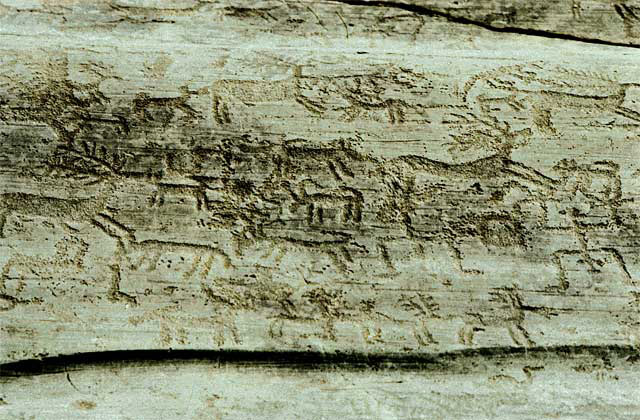Fig. 1
NOBART: ORIGINS 2.
The Sole to Pole Ratio: Early Beginnings
Prof. Belle Ennde
The Valcamonica valley in Northern Italy, nestled between the lakes of Como and Garda, is home to one of Europe's richest collection of rock art. The inviting surfaces of limestone and other calcareous rock were left open to prehistoric people as the ice caps retreated, willing the valleys inhabitants to whip out their tools and start banging away. And naturally, that's what they did. The rock art of the Valcamonica valley consists typically of zoomorphs or anthropomorphs many depicting hunting scenes as can be seen in fig 1. Later images dating from the first metal age also commonly feature tools. In fig 2. we can see one such example. A little figure almost dwarved by his massive tackle, he is out among the other horned animals, waving his weapon about and generally causing havoc.
The Nobservatory has been speculating wildly and groundbreaking research is currently being conducted in the area. A distinct feature in Valcamonican rock art is the random depiction of footprints, "footsoles", which have stumped experts for decades. Nobservatory researchers believe Valcamonica may be the first known source of the largely mythologised "sole to pole ratio" of phallic measurement. The footprints occur in pairs all over the site and whereas in other European rock art, depictions of footsoles are often easily identified as some sort of directional indicator, the Valcamonica ones are bunged anywhere, willy-nilly as it were. The Nobservatory is now championing the view that they were created as a scale against which a chap could measure his chap, the image in figure two supports this hypothesis. Though a very basic anthropomorphic study, the cock is clearly prominent, and closer comparison between the dimensions of the todger against those of the tootsies reveal a startling Vitruvian ratio. The length of the foot is equal to the breadth of the fully extended knacker sack which bisects the main shaft at precisely the point where another footsole-length from the tip terminates, then another 0.6 of a footsole to where it joins its character. A revelation in what we knew of early-man maths. Or early man-maths. To have been endowed with such a generously, not to mention perfectly proportioned winkie, this character must depict a someone very important in the settlement - the cock of the village, perhaps.
Fig. 2
Sources:
Scarre, C. The Human Past, London (2009)
Scarre, C. The Human Past, London (2009)
Paul G. Bahn, J. David Lewis-Williams, Christopher Chippindale, Jarl Nordbladh, Polly Schaafsma, David Frankel "Rock Art" The Oxford Companion to Archaeology. Brian M. Fagan, ed., Oxford University Press 1996. Oxford Reference Online. Oxford University Press. The Open University. http://www.oxfordreference.com/views/ENTRY.html?subview=Main&entry=t136.e0372-s0003 [13 February 2012]
Maretta, A "Digging the Past: 100 years of research on Valcamonica Rock Art" (n.d.) http://www.scribd.com/Alberto%20Marretta/d/19769466-Digging-The-Past-100-years-of-research-on-Valcamonica-rock-art [13 February 2012]
Image: OUA251 Rock Gallery, Open University [13 February 2012]



No comments:
Post a Comment